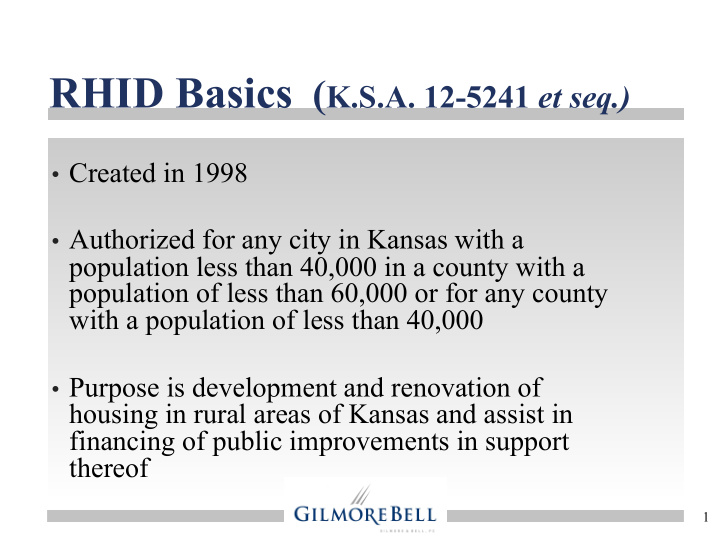



RHID Basics ( K.S.A. 12-5241 et seq.) • Created in 1998 • Authorized for any city in Kansas with a population less than 40,000 in a county with a population of less than 60,000 or for any county with a population of less than 40,000 • Purpose is development and renovation of housing in rural areas of Kansas and assist in financing of public improvements in support thereof 1
Redevelopment District • Defined by the City or County establishing the District • Based on Housing Needs Analysis – Shortage of quality housing – Shortage is expected to persist – Shortage is a substantial deterrent to future economic growth – Development of quality housing dependent on incentives 2
How RHID Works • Captures 100% of incremental real property taxes created by a housing development project • All taxing districts included • Up to 15 years per project 3
Redevelopment Plan & Project • Redevelopment Project Plan – Overall blueprint for the assistance of housing development in a District • Redevelopment Project – Specific project described in Redevelopment Plan – Each Plan can have multiple projects 4
Funding Methods • Developer Reimbursement – Developer finances approved RHID costs • Reimbursed as increment is received • Bond Financing – Special Obligation Revenue Bonds • Issued by creator of District • Limited obligation • May be purchased or guaranteed by developer and re-sold once valuation established • Other revenue sources (e.g. franchise fees, local sales taxes) – Full faith and credit (general obligation) bonds prohibited – Temporary notes may be used for interim financing 5
Permitted Uses of Bond Proceeds • Acquisition of property (eminent domain prohibited) • Payment of relocation assistance • Site preparation • Sanitary and storm sewers and lift stations • Drainage conduits, channels and levees • Street grading, paving, curbs and gutters • Street lighting • Underground public or private utilities • Sidewalks • Water mains and extensions • May NOT be used for buildings or structures to be owned by or leased to any developer 6
The “ Base ” and the “ Increment ” Base Property Assessed Value - $100,000 Total Mill Levy – 150 mills $360,000 Amounts Property Total Tax Revenue - $15,000 Change Tax Based Increment On Property Tax Increment Valuation Total Assessed Value After Development - $2,500,000 Total Mill Levy – 150 mills $15,000 $15,000 Total Revenue - $375,000 Amount Base Base Less Base (15,000) Remains Constant Total Increment - $360,000 7
Effect on Taxing Districts • All taxing jurisdictions held harmless at Base property tax level • When RHID bonds are retired, total valuation (including increment) restored to all taxing jurisdictions 8
District Formation Procedures • Preparation of Housing Need Analysis • Resolution finding shortage of quality housing • Secretary of Commerce approves findings • Negotiation of Development Agreement • District boundaries identified and development Plan prepared • Resolution Calling Public Hearing on District creation and adoption of Plan – Hearing date not less than 30 days nor more than 70 days following adoption of Resolution • Notice delivered to Planning Commission, School District and County/City • Published Notices – Notice published not less than 1 week nor more than 2 weeks prior to hearing • Public Hearing on District Creation and adoption of Plan • Ordinance/Resolution creating District and adopting Plan • 30-day Protest Period – School District or County/City finding that District will have adverse effect 9
Questions? 10
Recommend
More recommend